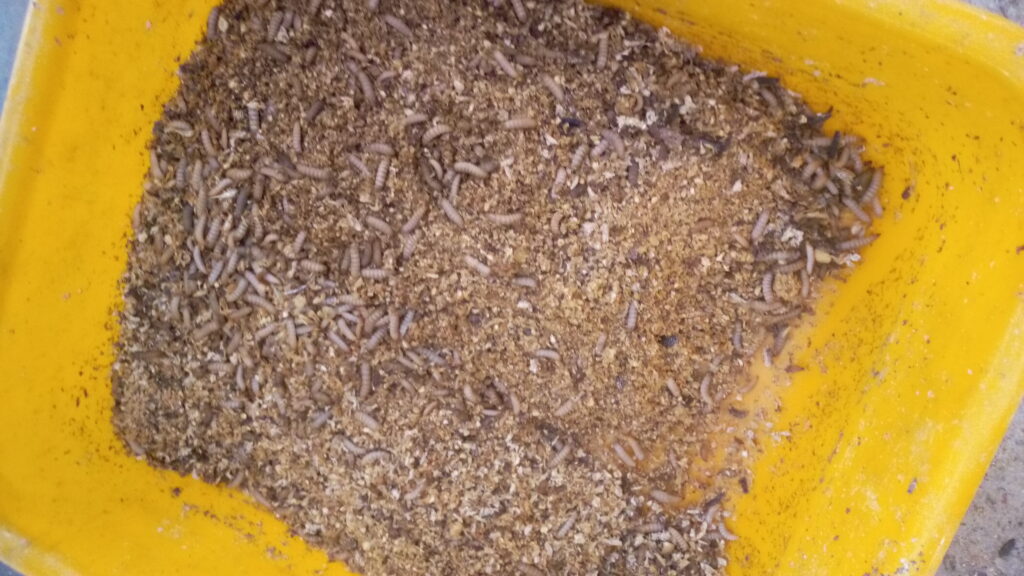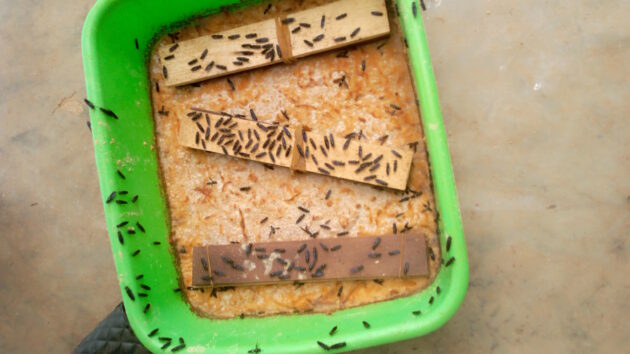
News & Views
Fish Nutrition
Nutrition & Feed products
Uganda scientists use black soldier larvae as fishmeal alternative
March 2, 2023 By Bob Atwiine
 Samples of already hatched black soldier larvae feeding on substrate (Photo: Bob Atwiine)
Samples of already hatched black soldier larvae feeding on substrate (Photo: Bob Atwiine) Scientists in Uganda have proved that insects such as black soldier fly larvae have potential to be used as an alternative source of protein in fish feeds in order to overcome increase in prices for fish feeds caused by contractions in the global economy due to the pandemic and Russia war on Ukraine.
In Africa, most economies suffered a sharp contraction as a result of the measures implemented in urgency to prevent the spreading of the virus, the demand and supply sides of the fish food chain have been disrupted, resulting in reduced livelihoods and economic vulnerability.
Much as a number of farmers are adopting the use of insect larvae as feed especially for their poultry, most aqua culture fish farmers in the country depend on fish feed processed from silver fish as high protein ingredient.
However, research scientists at Uganda’s Aquaculture Research and Development Centre which focuses on fish feed development having realized the increased high prices of silver fish which is the major protein mixture in fish feed decided to look for an alternative cost effective insect based protein feed to drive the needed requirements for the growing aquaculture industry .

Denis Opio, research assistant during interview at Aquaculture Research and Development Centre, Kajjansi, Kampala (Photo: Bob Atwiine)
Black soldier larvae
Denis Opio a research officer who is part the initiators of this research says the black soldier fly larvae contains up to 55 per cent protein which is comparable to that of fishmeal made from silver fish.
Opio says the larvae are best easily digestible by the fish in early growth stages which is from second to fourth growth stage.
“The reason is that as the larvae grows it develops an exoskeleton composed of protein called Chitin that protects its internal organs and not easily digestible by the fish,” Opio says.
He adds that black soldier flies are prolific breeders with a short life cycle of seven to eight days and can be grown in large quantities using substrates or waste organic material. They contain protein, fat and required minerals relevant for fish to grow.
Trapping flies
According to Opio, black soldier flies exist in the environment but says very few people know them because they are very secretive.
“Since we know that they are in the environment and we understand their biology and life cycle, we use that knowledge to trap them from our environment,” Opio explains.
Since adult black soldier flies look for a source of food that would sustain their off springs when they die after laying eggs, Opio explains that decomposing organic matter is placed in a strategic location where they are trapped using a net after coming to lay eggs.
“We gather them and take them to a shelter which can be a greenhouse with net cages, egg traps, where artificial reproduction process can be initiated for multiplication. You don’t need too many, you only need to start with a pair, males and females,” he adds.
Therefore, in order to obtain them in large numbers, it is advisable to place containers in an area with bright light. Light attracts the females to come and lay eggs on the substrates.
“The females normally lay eggs in dry gaps of cardboards which we place in the containers with substrates that they feed on. Once the eggs are sighted, they are transferred to fresh substrate of maize or wheat bran and in two to three days you see tiny maggots hatching,” he notes.

Samples of black soldier fly feeding on a substrate and cardboards where they lay eggs inside a container (Photo: Bob Atwiine)
Larvae as fish feed
Opio explains that it is possible to feed the fish directly on live larvae especially for catfish but warns that overfeeding on raw larvae over fattens the fish which is not desirable for most consumers because the latter has too much fat.
“Black soldier fly has a lot of fat, when we are doing feeding experiments, we kill the larvae by boiling it in hot water, dry it and grind it to formulate the feed,” Opio explains.
It is mixed with other ingredients such as wheat bran, sunflower cake, cotton cake and soy cake which are source of carbohydrates in order to have a complete feed.
Opio notes that the team has been carrying out this experiment for two years now and have proved that the fish feed using black soldier fly is viable because the insects are there in the wild.
The team is now at the process of working out certifications to enable massive production.
Fish feed processing
Opio explains that the steps of fish feed processing cut across the various types of fish feed that are availed by aquaculture fish farmers across the country.
Different fish species have different protein requirements therefore tilapia and cat fish which are bred by aquaculture fish farmers in the country require fish meal with about 60 per cent of protein for their growth.
Formulation and processing
According to Opio, it is important to have the correct mix of fish meal ingredients in order to process desirable fish meal.
“When we are doing formulation, we set the amount of fat, proteins, energy and minerals that should be used in the feed. That means that you control how much fat you are using in the feed” He says.
The mixing and grinding is done using the grinder and properly mixed. Then blending additives which contain palatable flavour can be added.
The crushed powder is then precooked in a steam in order to make it palatable and killing any other pathogens that may be harmful to the fish.
“After formulation we feed the fish and keep analyzing the level of growth to enable us decide the correct level of black soldier fly that we need in the feed”.
Opio further reveals that they have already conducted market intelligence in various districts and farmers are already interested and yearning to see the product on the market because it is cheaper compared to other imported feeds.
Apparently silver fish with higher protein is very scarce and costly on the market ranging from 7,000 Uganda shillings (US$1.8) per kilogram which makes final price of the feed more expensive.
However, Opio says with black soldier fly, fish feed will cost less than a dollar making it cheaper alternative for the farmers.
Print this page
Advertisement
- Responsible Seafood centre announces new shrimp industry event in Vietnam
- Is fishmeal availability going to be stable in 2023?





